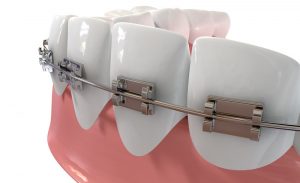 The wires that hold your braces together are called archwires. There are two archwires, one for your top arch (or top teeth) and another for your bottom arch (bottom teeth). These wires move your teeth until they are in their proper places.
The wires that hold your braces together are called archwires. There are two archwires, one for your top arch (or top teeth) and another for your bottom arch (bottom teeth). These wires move your teeth until they are in their proper places.
How do archwires straighten your teeth? And are there different types of archwires? Let’s find out.
What is an archwire?
An archwire is a piece of thin metal that is threaded through the brackets of your braces. While the brackets bind the wire to each tooth, the wire puts pressure on the handle and gently moves each tooth into the proper position. The wires also serve as tracks that guide the shifting of the teeth.
Archwires come in various compositions, shapes, and thicknesses. They can be square, round, or rectangular. The type of wire you use will depend on the stage of orthodontic treatment. As your teeth straighten or move into place, your orthodontist will switch to stronger and less elastic archwires.
Types of wire
The three most common types of archwires are those made from stainless steel, beta-titanium, and nickel-titanium.
Stainless steel archwires are strong, adjustable, and hygienic. But they’re not very elastic, which is why they’re not the best option for the initial stages of orthodontic treatment.
Beta-titanium archwires have a level of strength and elasticity somewhere between that of stainless steel and nickel-titanium. Some orthodontists choose this type of wire during the middle of orthodontic treatment when they start to need a stiffer wire.
Nickel-titanium archwires are the most elastic of these three. After being deformed, they are able to bounce back to their original shape. Nickel-titanium wires are perfect for the initial stages of treatment when the orthodontist needs to put pressure on the teeth.


How can I tell the type of archwires in my mouth, since my Doc. Closed the clinic and left no records.
Thanks in advance
it will appreciated if detail clarification,about,orthodontic wire number 16,18, could placed here